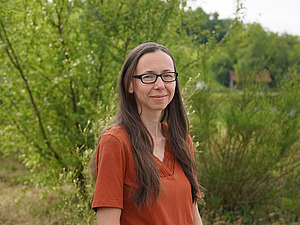"We are in a state of limbo when it comes to climate policy, waiting and doing nothing"
Voices on climate
Sabine Reinecke has been working as a policy analyst at FiBL Switzerland in the Department of Food System Sciences since 2023. (Photo: FiBL, Andreas Basler)
Sabine Reinecke has been working as a policy analyst at FiBL Switzerland in the Department of Food System Sciences since 2023. She is also currently setting up a small agroforestry business with her partner in Baden-Württemberg. During her academic career, she has focused extensively on land use in the context of international climate and biodiversity policy.
At the end of June, an important meeting of the Climate Framework Convention came to an end almost unnoticed. The annual "Climate Talks" in Bonn traditionally set the course for the major conference of the signatory states at the end of the year. This year, it will take place in Belém, Brazil, in the heart of the Amazon, 30 years after the first major climate conference in Berlin.
At 2.8 degrees, Switzerland is already well above 1.5 degrees
By September 2025, the signatory states are to submit their national climate protection contributions for the second time and demonstrate that they are on track to meet the target of keeping global warming below 1.5 degrees, as agreed in 2023. Switzerland has already completed its report for early 2025. While the world is still trying to keep global warming below 1.5 degrees, average temperatures in the Alpine country have long since risen to 2.8 degrees above pre-industrial levels. In 2024, the average was even 3.3 degrees higher.
At the same time, Switzerland's contribution of 0.1 per cent to the global climate budget and an average of just over 4.8 tonnes of greenhouse gas emissions per capita is exemplary. But is that enough? Can a high-performing nation like Switzerland rest on its laurels with such average figures? The need for action seems too urgent – especially in agriculture – to wait and see.
Milder winters disrupt natural cycles
In Switzerland, agriculture is already practised under difficult conditions in order to maintain a high degree of self-sufficiency. The threat of crop failures poses an enormous risk, and farmers have little financial leeway for the necessary adaptation investments.
According to the climate strategy, an additional CHF 100 million per year is to be spent on sustainable climate protection and adaptation measures in the sector, including advice and further training. However, the current federal budget strangely focuses on instruments that do little to promote transformation, such as sales and cultivation subsidies for sugar beet, while at the same time cutting research and education funding.
More decisive action is needed.
In the agricultural sector in particular, it is important to increase resilience to crises and become less dependent on global markets. Local production adapted to climate change is needed to serve as a safety net for the population's food supply and generate secure incomes for farmers. Switzerland is still a long way from achieving a balanced food system. A system that follows location-appropriate, resource-efficient and climate-smart principles in production and consumption in order to sustainably ensure self-sufficiency in healthy food.
As called for in the "Climate Strategy for Agriculture and Food 2050", more decisive action is needed from all actors along the value chain: from consumption patterns and food waste to reduction pathways and new production approaches in animal husbandry and crop production. This could be achieved through the massive expansion of agroforestry or through animal husbandry that does not require concentrated feed and closes material cycles.
Architects of AP30+ should remember climate strategy
While politicians are still haggling over suitable instruments for future agricultural policy (AP30+), Switzerland finds itself in a disastrous state of limbo when it comes to climate policy, waiting and doing nothing. Such procrastination is only bearable in the hope that the architects of AP30+ will remember the "climate strategy" in their search for sustainable agricultural policy instruments. The federal offices have jointly developed 42 measures that are fairly targeted, systemically thought out and, in some cases, already underway.
Sabine Reinecke, FiBL
Further information
Contact
Link
blw.admin.ch: Federal climate strategy




